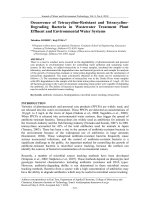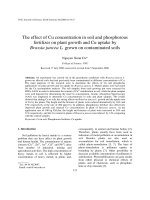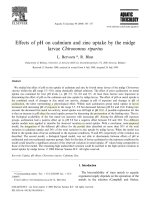Polyester plant precommisioning and start up
Bạn đang xem bản rút gọn của tài liệu. Xem và tải ngay bản đầy đủ của tài liệu tại đây (6.77 MB, 146 trang )
Polyester:
- Organization of Precommissioning
and Start-up
- Heating Procedure
- Start-up Procedure
Content:
1. Organisation of Pre-Commissioning and Start-up
1.1 Definition of Expressions
1.2 Personnel Organisation
1.3 Work Organisation
1.4 Field check and Pre-commissioning of the Chemical plant
2. Pre-Commissioning
2.1 Commission of Equipment
2.2 Pre-Commissioning of Paste Mixing and Espree Reactor
2.3 Pre-Commissioning of Discage Reactor
3. Initial Start-up of Esterification and Polycondensation
4. Normal Operation of Esterification and Polycondensation
5. Normal Shutdown of Esterification and Polycondensation
6. Emergency Procedures
1. Organization of Pre-Commissioning and Start-up:
1.1 Definition of Expressions
Field Check / Completion of Erection / Pre-Commissioning / Mechanical Completion /
Initial Start-up / Commissioning / Acceptance
Field Check / Completion of Erection:
The field check is the final check of the erection work.
For each plant section in which erection work is completed the field check is done by a mixed
team usually consisting of erection and process people from BUYER and SELLER side.
When all checks are completed a protocol is signed by both parties which states that the plant
is ready for pre-commissioning. Minor points can be settled after completion of erection and
must be mentioned in this protocol.
By signing this protocol the START-UP TEAM takes over the responsibility for the plant from
the ERECTION TEAM.
Pre-Commissioning / Mechanical Completion:
The pre-commissioning covers the activities between completion of erection and
mechanical completion.
Each item shall be checked as far as possible to assure that it can fulfil its duty in the running
plant. Cold checks (calibration, leakage tests, control functions), hot checks (heating, hot bolting,
hot vacuum tests) and trial runs has to be done.
Operator training is done on the job, for heating the plant the shift organisation is established.
When all preparation work is finished and everything is ready for a safe initial start-up of the
plant both parties sign the protocol of Mechanical Completion.
1. Organization of Pre-Commissioning and Start-up:
1.1 Definition of Expressions
Field Check / Completion of Erection / Pre-Commissioning / Mechanical Completion /
Initial Start-up / Commissioning / Acceptance
Initial Start Up:
Defines a phase of activities after mechanical completion from the first feed of raw material
into the first reactor until normal operating conditions are reached.
Commissioning / Acceptance:
The commissioning covers the period from the time when raw material is fed up to the
Date of Acceptance.
It includes the following steps:
- initial start up / - optimisation of the plant / - performance test
After the successful performance test the protocol of plant acceptance
shall be signed by
both parties.
1. Organization of Pre-Commissioning and Start-up:
1.2 Personnel Organisation
Personnel Requirements:
The success of commissioning and start-up activities depends to a competent organisation of
personnel. Such start-up teams should consist of the following elements:
Technical operating group:
Graduate engineers chosen especially for start-up and later plant operation.
Plant management group:
This should be a mixed team of supervisors, composed of engineers from SELLER and BUYER,
as well as delegates from the contractor and the supplier companies.
Maintenance group:
The maintenance group will take over the responsibility for the equipment when the contractor's
people have left the site.
Laboratory group:
Should be able to use laboratory equipment as soon as plant testing with product has been initiated.
Delegates of Sellers and Suppliers:
Experts for planning and execution of field check, pre-commissioning and commissioning activities.
Experts for the respective package units.
1. Organization of Pre-Commissioning and Start-up:
1.3 Work Organisation
A network plan and a time schedule are indispensable tools for the planning and coordination
of the plant start-up activities.
Every major target can only be reached on schedule when a daily list of job activities is made.
Each job is checked periodically to establish whether its completion is delayed due to problems
or if regular progress has been achieved.
The problems which arise are discussed during a meeting among the parties responsible.
A NETWORK plan is used for visualization of the pre-commissioning progress.
The network plan consists of states (targets and completeness of states in percent) and activities
such as field check, dry check, wet check, heating, trial runs, initial runs etc.
The network plan has to be prepared prior to pre-commissioning activities.
All sections and the states (targets) must be listed.
In order to define certain states, the progress according to the activity list is used.
The pre-commissioning activities are recorded on ACTIVITY LISTS.
The activity lists are numbered section wise or group wise.
They are handed over to the plant section leader prior the pre-commissioning respective
preparation work.
With these documents, control over the large number of parallel activities is achieved.
A time schedule can be evaluated and also revised periodically.
1. Organization of Pre-Commissioning and Start-up:
Network plan
1. Organization of Pre-Commissioning and Start-up:
Network plan
1. Organization of Pre-Commissioning and Start-up:
1. Organization of Pre-Commissioning and Start-up:
Precommissioning: Activity List (Excerpt)
1. Organization of Pre-Commissioning and Start-up:
Pre-Commissioning Standard Steps
Field Check
Erection Completion
Dry Check
without water or other liquids,
e.g. valve calibration, tightness test
Wet Check
with water and/or EG,
e.g. level calibration, pump circuits
Initial Run
start-up of a single section
Cold / Hot Vacuum Check
vacuum test of reactors
Heating
1. Organization of Pre-Commissioning and Start-up:
1.4 Field check and Pre-commissioning
The pre-commissioning is divided into the following main activities:
1.4.1 Field Check (
erection must be completed)
1.4.2 Dry Check (
without water or other liquids, e.g. valve calibration, tightness test)
1.4.3 Wet Check (
with water and / or EG, e.g. level calibration, start of pump circulation)
1.4.4 Heating
1.4.5 Trial Run (
start-up of a single section)
1.4.6 Initial Run (
start-up of a single, independent process section such as additive)
1.4.7 Critical path and the related activities
1.4.8 Safety recommendations and requirements
The main activities can be executed only in the sequence displayed above.
Each deviation from this sequence can cause difficulties in a later stage of the
pre-commissioning.
The main activities are listed in the Start-up Activity list.
The list of activities must be discussed in detail in the start-up team.
1. Organization of Pre-Commissioning and Start-up:
1.4 Field check and Pre-commissioning
1.4.1 Field Check
The following points on behalf of design and erection must be checked during the Field Check
in order to assure the optimal functionality of the plant:
- Completion of erection according to PID
- Installation of equipment, instruments, valves and armatures according to the instruction given
in the Mechanical Catalogue
- Transport locks removed
- Lubrication material filled
- Quality of material of piping, gaskets, valves and armatures
- Nominal diameter and pressure of pipes checked
- Slope in piping systems where required for example for drain and vent
- Steam tracing on piping systems in which medium can freeze due to ambient temperatures
- Stress free erected equipment and piping (expansion joints, expansion guides).
- Position of drain and vent valves (drain valves at the lowest and vent valves at the highest
points in the piping systems).
- Access to equipment, valves, armatures and instruments for operation and maintenance
- Space for removing or dismantling of equipment (agitators, heat exchanger bundles, eccentric
screw pumps), filter inserts, spray nozzles, valves and instruments
- Connection of electric and instrument cables and instrument air
- Equipment according to hazardous area classification
- Fire fighting equipment properly installed
1. Organization of Pre-Commissioning and Start-up:
1.4 Field check and Pre-commissioning
1.4.2 Dry Check
The Dry Check can begin as soon as the Field Check has been completed.
The Dry Check is the mechanical and electrical function check for all equipment, instruments
and automatic valves. In the Dry Check no media such as products, raw materials, heat transfer
medium or utilities are involved.
The Dry Check includes:
- Cleaning of piping systems and equipment
- Cleaning of vessels and heat exchangers
- Leakage test on piping systems, reactors and heat exchangers (HTM evaporators)
- Checking of the signals from the process control system and the main control cabinet (MCC)
to the instruments and automatic valves
- Function check of instruments and automatic valves.
- Calibration of instruments which can be calibrated in the instrument work shop
- Adjustment of automatic valves including the fail safe position
- Function check of interlocks
- Mechanical check of machines and apparatuses
1. Organization of Pre-Commissioning and Start-up:
1.4 Field check and Pre-commissioning
1.4.3 Wet Check
The Wet Check can be started as soon as the Dry Check has been completed and the utilities are
available. The Wet Check is done in cold condition (except steam tracing).
Usually demineralised water (WDR) is used in vessels and pump circuits. The use of ethylene
glycol (EG) must be controlled strictly since a limited quantity of EG can be stored inside of the
production building. No water must be filled into the HTM (and fuel oil piping systems if existing).
HTM and fuel oil can be used instead for the Wet Check.
For the Commissioning of Equipment consult the Operating Manual Vol. 1A, point 7 and the
Mechanical Catalogue of each equipment.
The Wet Check includes:
- The start-up and run-in of pumps
- The operation of pump circuits
- The start-up and run-in of agitators
- The start-up and run-in of other machines
- The function check of heat exchangers
- The calibration of instruments in the field (such as level and flow instruments)
- The adjustment of control circuits
- The function check of control sequences
The run-in of machines should be for one week at least. Most gears require a lubrication
change after the run-in period.
The system must be thoroughly dried, where ever presence of water is not desirable
1. Organization of Pre-Commissioning and Start-up:
1.4 Field check and Pre-commissioning
1.4.4 Heating
The Heating can begin as soon as the Wet Check has been completed.
The Heating must be co-ordinated between all involved sections of the plant:
- Heating plant and HTM systems
- Esterification reactor systems, including columns and product lines
- Polycondensation reactor systems, including spray condensers and product lines
- Melt discharge, melt filter and melt distribution lines
- Product drain systems of esterification and polycondensation
- Extrusion head of chipping unit
Heating-up of any system causes thermal expansion of the equipment (piping and apparatuses)
and the medium (liquids and gases) inside of the equipment.
Liquids can evaporate inside of the equipment during heating-up.
Do not heat-up any closed piping and apparatus system.
Check the safety armatures and instrumentation before heating-up.
1. Organization of Pre-Commissioning and Start-up:
1.4 Field check and Pre-commissioning
1.4.5 Trial Run
The Trial Run can begin as soon as the Heating or for these sections where no heating-up
is required the Wet Check has been completed. Wherever possible the Trial Run is done
under normal operating conditions.
The Trial Run includes:
- The final check of the equipment
- The final check of the instrumentation
- The final function test of the control sequences
- The final function check of the interlocks
- The adjustment of the control circuits
Beside the Trial Run, the training of the operators on the process control system and in the field
is most important.
For the Trial Run instead of product, alternative materials can be used such as a water/EG mixture
for the distillation tests in the esterification reactor and column systems.
1. Organization of Pre-Commissioning and Start-up:
1.4 Field check and Pre-commissioning
1.4.6 Initial Run
In some sections (natural gas supply, EG and PTA transport, additive preparation,
paste mixing and spent EG recycling) an Initial Run can be done prior to the initial
start-up of the plant.
The Initial Run is done under normal operating conditions with the real process materials.
Use the following documents as a guide:
together with check lists:
Start-up Preparation Chemical Section
List of Activities for Start-up .
1. Organization of Pre-Commissioning and Start-up:
1.4 Field check and Pre-commissioning
1.4.7 Critical path and the Related Activities
From experience the critical path can be drawn in the network:
- Field Check on HTM system
- Dry Check on HTM system (leakage test)
- Wet Check on HTM system (filling and drying of HTM)
- Initial Run of HTM plant
- Filling of HTM evaporators
- Heating of the plant
- Trial Run of vacuum system
- Hot vacuum check on polycondensation reactor systems
- Trial run of polycondensation reactor systems
1. Organization of Pre-Commissioning and Start-up:
1.4 Field check and Pre-commissioning
1.4.8 Safety Recommendations and Requirements
read carefully: Safety Recommendations and Requirements
Doc. No. IZ-11915
In the Operating Manual, Volume 1A, point 5
and act accordingly.
Safety must receive highest priority. The necessary systems and devices must be on site and
functional prior to the initial start-up:
- Training in safety
- Instruction in the use of devices
- Safety regulations (welding permit)
- Fire fighting equipment
- Local extinguishers
- Goggles or face shields
- Heat resistance gloves
- Protective garments
- Gas masks
- Water hoses, pipes, and connections
- Emergency exits, fire escapes
- First aid station
- Location of HTM emergency drain push buttons
- etc.
2. Pre-Commissioning:
Before, and also during Pre-Commissioning, all the points discussed under
1. Organization of Pre-Commissioning and Start-up
needs to be done:
- Personnel Organisation
- Work Organisation
- Field check and Pre-commissioning
The commissioning of the individual Equipment belongs also under the expression of
Pre-Commissioning, therefore the content of this chapter is as follows:
2.1 Commission of Equipment
2.2 Pre-Commissioning of Paste Mixing and Espree Reactor
2.3 Pre-Commissioning of Discage Reactor
See also following documents in the Operating Manual:
- Commission of equipment:
Op.Manual, V: 1A, pt. 7, Doc. No. IZ-11917
- Pre-Comissioning Paste Mixing and Espree Reactor: Op.Manual, V: 3, pt. 8, Doc. No. IZ-11937
- Pre-Comissioning Discage Reactor:
Op.Manual, V: 3, pt. 9, Doc. No. IZ-11938
2. Pre-Commissioning:
2.1 Commission of Equipment
The commissioning of Equipment is divided into following activities:
2.1.1 Piping
2.1.2 Vessels and Heat Exchanger
2.1.3 Machines
2.1.4 Electrical Equipment
2.1.5 Instrumentation
2.1.6 Marking and Labelling
Each group leader who is responsible for the pre-commissioning of a section
must consult the respective Mechanical Catalogues and study the available drawings
before starting the work.
2. Pre-Commissioning:
2.1 Commission of Equipment
2.1.1 Piping
Pressure Test:
The mechanical strength of pipes and welding seams are checked at the end of erection by
pressure testing according to the instructions given in the Basic Document for Erection.
In order to avoid introducing any water into the HTM systems the pressure test of the HTM
primary and secondary liquid circulation systems can be done with HTM after the leakage
tests on these systems are completed.
Cleaning:
During erection, special care is taken that no dirt remains in pipes and equipment.
Dirt can damage armatures and machines.
Pipes are usually flushed during the field check period with water, steam or air.
2. Pre-Commissioning:
2.1 Commission of Equipment
2.1.1 Piping
Cleaning:
Take the following precautions when flushing pipes:
- disconnect all pumps, if necessary install fitting pieces and remove all inline instruments, etc.
- close or disconnect instruments such as pressure transmitters and pressure gauges
- flush only into vessels which can be cleaned afterwards and flush downwards
- do not flush pipes into columns, heat exchangers, etc.
- all blinds installed on equipment and piping must be removed after flushing
- before filling any vessel with water and before draining any vessel ensure that the vent of the
respective vessel is open to the atmosphere in order to avoid pressure or vacuum in the vessels
- after water flushing into vessels, drain the water through the various piping sections
- reinstall all instruments, orifices, control valves, etc., after flushing of the piping is finished
- in cases where equipment has to be dried after flushing do not install the instruments before
drying is completed
if pipes are flushed with compressed air avoid injuries to personnel caused by solid residue
flying from the exhaust
After flushing the piping systems a considerable amount of dirt may have accumulated in valves,
nozzles, strainers etc., such items have to be cleaned manually after flushing has been completed.
Do not flush the HTM piping systems with water
2. Pre-Commissioning:
2.1 Commission of Equipment
2.1.1 Piping
Leakage Tests:
The Pressure Maintenance Test is done at a pressure of max. 20 kPa(g). However the pressure
applied for the leakage tests must be lower than the design pressure of the system.
For leakage tests, nitrogen or compressed air are filled into the systems.
Ensure that all systems to be tested are protected against pressure exceeding the design
pressure of all equipment in the system.
In the Pressure Maintenance Test the tested systems are to include vessels and heat
exchangers, piping, instruments, valves and armatures.
The systems can be divided into smaller subsystems where leakage can be found more easily.
The pressure drop is observed over a period of 24 hours in order to avoid incorrect interpretation
of the result due to temperature differences between day and night.
All systems are tested in the cold state first. All flanges, instrument connections and welding
seams can be brushed with soapy water. Bubbles indicate leakage.
Do not use a testing pressure higher than 20 kPa(g) since this will reduce the formation of bubbles.
The tower reactor system (section 20) including the rectification systems can be tested for a
second time after heating-up. In the hot state leakage only can be eliminated by careful hot bolting.
For the polycondensation reactor system the Cold Vacuum Test follows the
Pressure Maintenance Test.









